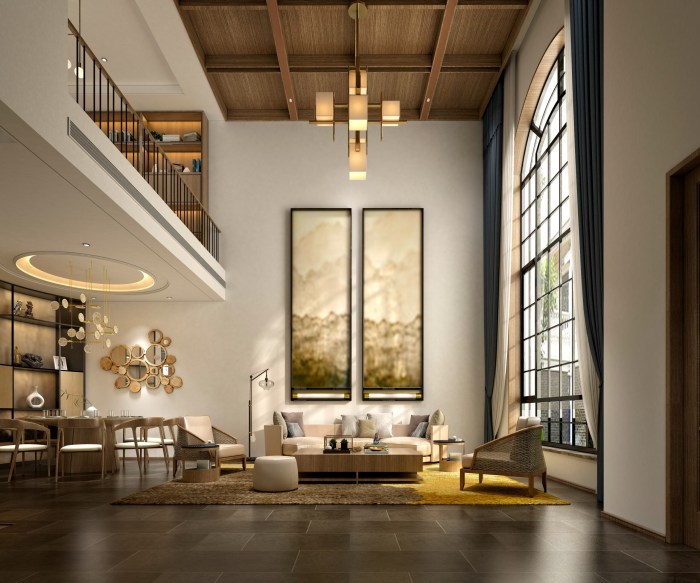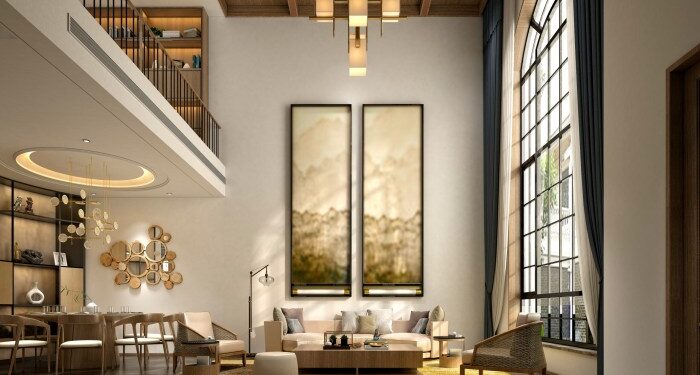Embark on a journey through the realm of interior architecture, where creativity meets functionality in a harmonious blend. Dive into the intricate details and captivating aspects of this dynamic field.
Discover the nuances that differentiate interior design from interior architecture, and unravel the profound impact it has on our everyday experiences.
Definition and Overview of Interior Architecture

Interior architecture refers to the design of indoor spaces with a focus on the structural elements and spatial layout that influence the functionality, aesthetics, and overall experience within a built environment. It involves the planning, designing, and coordination of interior spaces to enhance human interactions and activities.
Difference between Interior Design and Interior Architecture
Interior design primarily focuses on the decorative aspects of a space, such as furniture, color schemes, and accessories, to create a visually appealing environment. On the other hand, interior architecture delves deeper into the structural elements of a space, including walls, ceilings, floors, and lighting, to create a cohesive and functional design that integrates with the building's overall structure.
Role of Interior Architecture in Shaping Human Experiences
Interior architecture plays a crucial role in shaping human experiences within built environments by considering factors such as ergonomics, circulation, lighting, acoustics, and sustainability. Through thoughtful design decisions, interior architects can create spaces that not only look visually appealing but also support the well-being and comfort of the occupants.
The strategic placement of elements within a space can influence how people interact with their surroundings, leading to a more engaging and enriching experience.
Principles of Interior Architecture
Interior architecture is guided by fundamental principles that play a crucial role in the design process. These principles ensure that interior architects create spaces that are not only aesthetically pleasing but also functional and sustainable.
Balance of Form, Function, and Aesthetics
Interior architects strive to achieve a delicate balance between form, function, and aesthetics in their designs. Form refers to the physical shape and structure of a space, function relates to how the space will be used and by whom, and aesthetics focus on the visual appeal and emotional impact of the design.
A successful interior architecture project seamlessly integrates these three elements to create a harmonious and cohesive space.
- Form: Interior architects consider the layout, proportions, and scale of a space to ensure that the design is visually appealing and structurally sound.
- Function: The functionality of a space is of utmost importance in interior architecture. Architects must carefully plan the layout and circulation of a space to meet the needs of its users.
- Aesthetics: Aesthetics play a significant role in interior architecture, as they contribute to the overall atmosphere and mood of a space. Interior architects carefully select colors, textures, and materials to create a cohesive and visually pleasing environment.
Utilization of Space, Light, Materials, and Color
Interior architects utilize various elements such as space, light, materials, and color to create impactful designs that enhance the user experience.
- Space: Interior architects manipulate space by considering the flow of movement, spatial organization, and the relationship between different areas within a space.
- Light: Lighting is a crucial element in interior architecture, as it can dramatically affect the mood and ambiance of a space. Architects strategically plan natural and artificial lighting to highlight architectural features and create a comfortable environment.
- Materials: The selection of materials in interior architecture is essential for both aesthetic and functional purposes. Architects choose materials based on durability, sustainability, and aesthetic qualities to enhance the overall design.
- Color: Color plays a significant role in interior architecture by influencing the perception of space, mood, and visual interest. Interior architects carefully select color palettes to evoke specific emotions and create cohesive design schemes.
History and Evolution of Interior Architecture
Interior architecture has a rich history that dates back to ancient civilizations and has evolved significantly over the years. Let's explore the key milestones and influences that have shaped the field into what it is today.
Ancient Civilizations
Interior architecture can be traced back to ancient civilizations such as the Egyptians, Greeks, and Romans. These early societies placed great importance on designing and decorating interior spaces, with a focus on functionality and aesthetics. For example, the ancient Egyptians utilized elaborate hieroglyphics and intricate carvings in their interior spaces to symbolize their beliefs and values.
Key Movements and Styles
Throughout history, various movements and styles have influenced interior architecture. The Renaissance period, for instance, saw a revival of classical design elements and a focus on symmetry and proportion
In the 20th century, the Modernist movement championed simplicity, clean lines, and the use of new materials such as glass and steel.
Technological Advancements
Technological advancements have had a profound impact on the practice of interior architecture. The invention of electric lighting, for example, revolutionized how interior spaces could be illuminated and transformed. The development of computer-aided design (CAD) software has streamlined the design process and allowed for more precise and detailed renderings of interior spaces.
Additionally, sustainable design practices and the use of eco-friendly materials have become increasingly important in modern interior architecture.
Elements of Interior Architecture
Interior architecture is defined by a variety of essential elements that come together to create functional and aesthetically pleasing spaces. These elements are crucial in shaping the overall design and experience of a built environment.
Spatial Planning, Circulation, and Ergonomics
Spatial planning involves organizing and arranging the layout of a space to optimize functionality and efficiency. Interior architects carefully consider circulation pathways to ensure smooth movement within a space. Additionally, ergonomics play a key role in interior architecture, focusing on designing spaces that are comfortable and safe for occupants.
Textures, Patterns, and Finishes
Textures, patterns, and finishes are elements that add depth and visual interest to interior architectural design. These elements can evoke different emotions and enhance the overall ambiance of a space. Interior architects use a combination of textures, patterns, and finishes to create a cohesive and inviting environment.
Sustainability and Environmental Considerations
Incorporating sustainability and environmental considerations into interior architecture is becoming increasingly important. Interior architects strive to use eco-friendly materials, energy-efficient systems, and sustainable design practices to minimize the environmental impact of their projects. By prioritizing sustainability, interior architects contribute to creating healthier and more environmentally conscious spaces.
Interior Architecture in Different Settings
Interior architecture plays a crucial role in shaping the functionality and aesthetics of various settings, including residential, commercial, institutional, and hospitality spaces. The design approaches, challenges, and opportunities faced by interior architects can vary significantly depending on the context and user needs.
Residential Settings
In residential settings, interior architecture focuses on creating comfortable and personalized living spaces. Designers often work closely with homeowners to understand their lifestyle and preferences, incorporating elements that reflect their individuality. Renovating existing homes may involve preserving historical features while integrating modern conveniences, whereas new designs allow for more creative freedom.
Commercial Settings
Commercial spaces like offices, retail stores, and restaurants require interior architects to consider functionality, branding, and customer experience. Renovating existing commercial spaces often involves updating layouts to improve workflow and customer flow, while new designs may prioritize innovative technologies and sustainable practices.
Institutional Settings
Institutional settings such as schools, hospitals, and government buildings have unique requirements for safety, accessibility, and durability. Interior architects must create spaces that promote productivity, healing, or learning while adhering to strict regulations. Renovations in these settings often focus on modernizing facilities to meet evolving needs.
Hospitality Settings
Hospitality settings like hotels, resorts, and restaurants prioritize guest comfort, aesthetics, and functionality. Interior architects in this sector often focus on creating memorable experiences through innovative designs, luxurious amenities, and efficient layouts. Renovating existing hospitality spaces may involve revitalizing outdated features to attract modern travelers.
Final Wrap-Up
In conclusion, interior architecture emerges as a pivotal force in shaping our surroundings and enhancing our interactions with the spaces we inhabit. It bridges the gap between artistry and practicality, leaving a lasting impression on all who encounter its transformative power.
FAQ Compilation
What sets interior architecture apart from interior design?
Interior architecture focuses on the structural elements and spatial layout of a space, while interior design deals more with aesthetics and decor.
How do interior architects incorporate sustainability into their designs?
Interior architects integrate sustainable materials, energy-efficient systems, and environmentally conscious practices to create eco-friendly spaces.
What are some key historical movements that have influenced interior architecture?
Movements like Art Deco, Bauhaus, and Modernism have left a significant imprint on the evolution of interior architecture.














